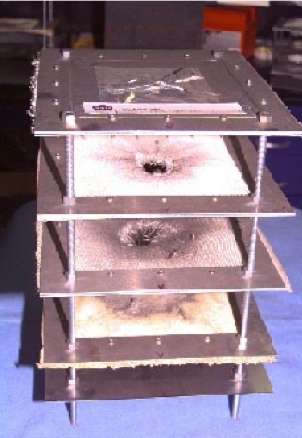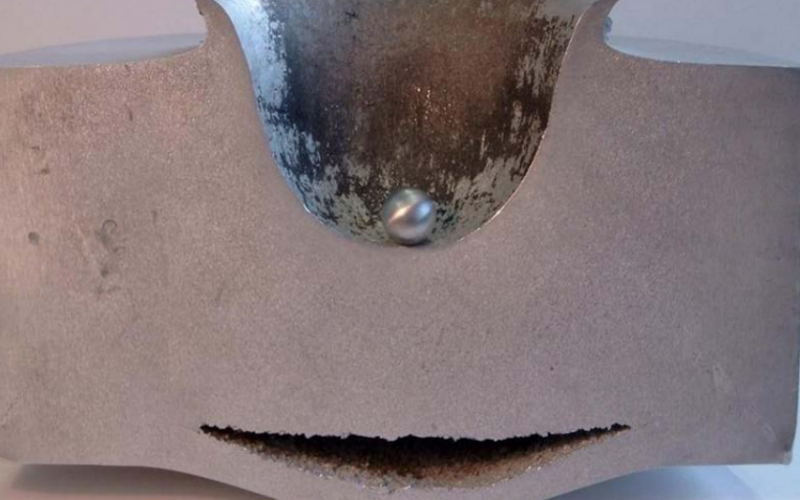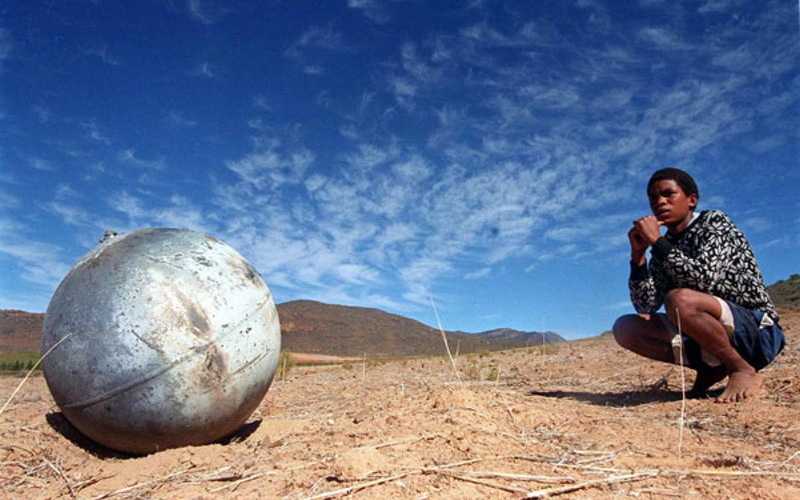Are the astronauts at risk of being hit by space debris? What can NASA do about it?
Astronauts are at risk in the International Space Station and during extra-vehicular activities (spacewalks). Their suits can protect them from extremely small particles and most of the ISS has shields to protect them from objects with sizes up to one cm in diameter. To protect them from larger objects, the Space Station must navigate out of the way or the astronauts can use the auxiliary Soyuz spacecraft as a “lifeboat.”

Can we protect the ISS and other satellites?
Whipple shields are used on the ISS. Most of the ISS shielding protect against particles up to about 3 mm in size. A Whipple shield is a multi-layered shield designed so that the first layer breaks up the impacting object; the second layer breaks those fragments into smaller objects, and so on until the fragments are too small to penetrate the last layer. The difficulty is that to shield against bigger objects, the shields must be bigger and eventually they become too heavy to launch and must be spaced too far apart. That is one of the reasons that the shields on the ISS do not protect it from everything that cannot be tracked.
What is the risk to people on the ground?
The overall risk to an individual from reentering debris is extremely small compared to the other hazards we face daily. It is estimated to be less than a one in one trillion chance that a particular person will be injured by falling space debris. By comparison, the risk of being hit by lightning is one in 1.4 million and the risk that someone in the U.S. will be killed in a hurricane is about one in six million.
What are debris clouds?
When an object in space breaks up or blows up, each of the pieces will fly in its own, independent orbit. These orbits are mathematically related to one another, and we can analyze them collectively as a “cloud.” Space debris clouds are not at all like clouds in the sky, or a cloud of ink in a beaker of water. Since there is no air or other medium in which the cloud is suspended, the cloud grows and changes shape based solely on the laws of orbital motion. In computer graphics, you can see the cloud grow and change shape as the cloud forms into a ring around the Earth. But in real life, on a human scale, the pieces are too small and much too far apart to actually see debris as a coherent cloud.
Can you see space debris coming at you?
It is very unlikely that you would see space debris. Relative to a person in orbit, space debris is moving about ten times faster than a bullet, and the vast majority of debris is as small as or smaller than a bullet. No one can see a bullet coming, let alone an object moving ten times faster.
What is an on-orbit collision like?
It looks more like an explosion of each object, as if they passed through each other and exploded on the other side. A hyper-velocity collision like those at orbital speed doesn’t behave like collisions that we are used to seeing. The objects are moving so fast that they travel through each other faster than the shock waves can travel. The shock waves in the structures of each object then shatter them into fragments of varying sizes and, in the process, give each fragment a boost in a different direction. Each one of these fragments is then in a different orbit than the original object and will move away according to the laws of orbital motion. With thousands of fragments, each moving in slightly different directions, it looks a lot like an explosion.
Do breakups look like the movies?
For dramatic purposes, movies, TV, and commercials tend to show space breakups at a much slower speed than they would happen at in real life. A breakup in space, especially a collision, can involve a lot of energy, and the pieces are flung away at extremely high speeds. Since there is no air to slow the pieces down the fragments would all fly away from one another and rapidly disappear from view. For many breakups, a softball-sized fragment would fly the length of the space station (a little less than a football field) in less than half a second. If you were watching it from nearby, you would see a flash, and the object that broke up would just disappear and be gone. It would be very unlikely for you to see pieces drifting away. Similarly, a low orbit space collision is unlikely to look much like a car crash — the speeds are much too high. The collisions would look like explosions to a nearby observer.
Are chain-reaction collisions or cascades real?
Unfortunately, yes. Mathematical modeling has repeatedly shown that the number of objects in low Earth orbit will likely grow from collisions, whether or not we launch more space missions. However, these cascades take place over decades and centuries, with a large collision happening currently only about once every five to ten years. So while the “Kessler Syndrome” — a scenario where space debris collisions cause a domino-effect resulting in an overwhelming amount of debris — is quite real mathematically, it is a slow-motion disaster that we have time to affect. If we start limiting the growth of space debris right now, we can prevent it from being an unmanageable problem.
Will space debris make it impossible to fly or operate in space?
No, this is very unlikely. Over many decades, the growth in space debris will make orbit operations more hazardous, and more costly. The growth of debris will make tracking and avoiding the debris more complicated, costly, and operationally difficult. It might be tough to perform a mission if frequent maneuvers are required to avoid debris. And a satellite would have to carry extra fuel for these extra maneuvers and would likely need to shield critical areas from collisions with small debris. Space debris can make space missions more costly and difficult, but it won’t make them impossible.
How do we know where space debris is located?
A Space Surveillance Network (SSN) operated by the U. S. Air Force tracks objects in space. The SSN has radar and optical sensors at various sites around the world as shown in the figure below. Theses sensors observe and track objects that are larger than a softball in low Earth orbits and basketball-sized objects, or larger, in higher, geosynchronous orbits. The sensors can determine which orbit the objects are in and that information is used to predict close approaches, reentries, and the probability of a collision. Other nations also run space object tracking systems.
If most debris is too small to be seen, then how do we know about it?
Some radar installations can see small objects pass through their beams, but can’t track them long enough to determine their orbit. We can determine the approximate amount of small space debris by counting these radar returns over a short period of time and then estimating the total. In addition, whenever we retrieve a spacecraft from orbit, we find that it is almost always pitted with debris strikes. Generally, the longer something has been in orbit the more hits it has. Collecting this type of data from multiple sources allows us to estimate the total number of objects in orbit. We can also estimate the number of particles created by collisions and explosions using models that simulate the breakup.
Who is responsible for creating space debris? Tracking it? Controlling it?
The nations that launch and operate satellites are responsible for the space debris from their satellites and rocket bodies. There is no one responsible for tracking it internationally, but the United States does track space debris to protect our own satellites, and we share some of that information with the rest of the world. Other nations also have tracking capabilities and perform similar services for their satellites. Satellite operators try to reduce space debris from recently launched satellites and rocket bodies by carefully designing them to prevent explosions, reentering them, or moving them to disposal orbits— essentially a space junkyard— when their mission is over. Space debris from older objects, explosions, and collisions is not controlled at all.

Isn’t there an “air traffic control” in space? Doesn’t NASA do that?
There is no way to control objects that are inactive. In addition, there is no way to control objects that may still be active but are unable to maneuver— such as the Hubble Space Telescope. And finally, even when we have a satellite that can maneuver, it’s not like air traffic control telling an airplane to climb, descend, or turn. A satellite coasting in an orbit adheres to the laws of physics and unless there is ample warning time, it can take a lot of energy to alter that orbit to avoid a collision.
The closest agency to an air traffic control system is the US Air Force’s Joint Space Operations Center. The JSpOC operates the Space Surveillance Network and maintains the most complete catalog of objects on orbit. If they predict a collision between a cataloged object and a known operational satellite, they usually attempt to notify the owner/operator. The JSpOC monitors the ISS and other NASA satellites for collisions. Other nations use JSpOC data as well as their own tracking data to protect their satellites. To date, there is no internationally recognized “Space Traffic Control” agency.
With the closure of the space fence, who’s tracking debris?
The Space Fence— also known as the Air Force Space Surveillance System— is only one part of the space surveillance network and all of the other tracking stations are still operating. However, closing the space fence does make tracking more difficult and degrades our ability to accurately track space debris.
Will the space debris problem take care of itself?
In low Earth orbit (below 600 km or 370 miles), the little atmosphere that is there will, over weeks, months, and years, drag the space debris low enough to reenter. Between 600 km and 1000 km (620 mi) it may take tens to hundreds of years for the debris to reenter. So it’s possible that some of the debris will be removed naturally. The problem is that space debris objects can collide with each other and produce more debris.

What can we do to keep the problem from getting worse?
The most straightforward thing to do is to not leave more objects in orbit once they are no longer useful. There are international guidelines for doing this from the Inter-Agency Space Debris Coordination Committee (IADC) (https://iadc-home.org/what_iadc). Many nations, including the United States, have rules about getting rid of old satellites and rockets. The problem is that it can be difficult and expensive to eliminate old spacecraft, especially if the satellite or rocket was not designed for disposal. Furthermore, having satellites and rockets dispose of themselves will not work for objects that are already in orbit and are uncontrollable.
Can we clean up the space debris?
There is no easy or cheap solution to the space debris problem. Cleaning it up will be very expensive and take many years. The big debris, like used rockets, is most likely to create more debris and is heavy and difficult to move. The small debris that can still damage a satellite is very hard to find and track and there are very large quantities of it. Both types of debris are difficult to remove for their own reasons.
How can we clean up the space debris?
We can’t just vacuum or sweep it up into a space garbage truck. To remove space debris, particularly the large and more dangerous objects, we have to get close to it and maintain the same speed as each object. We then, somehow, must attach to it, and move it into a lower orbit or reenter it directly into the ocean. If the object is a rocket stage with propellant still on-board, there is an explosion risk and that’s why we would never let astronauts perform this task. There is also the issue of property rights; you can’t grab a satellite or rocket that belongs to another country without their permission. There is no easy way to control the small-but-dangerous objects that are not well tracked or not tracked at all. They have more kinetic energy than bullets, and they are moving ten times faster. It is hard to catch a bullet, especially if you don’t want to create more junk while doing it.
How far in advance can you predict a collision or a reentry?
We can reasonably predict close approaches in space beginning a week prior to the event. Predicting where space debris will reenter and land is much harder to do because we don’t know when the object will actually enter the denser atmosphere and begin its final dive. Reliably predicting a reentry location more than a day ahead of the event is difficult, and even then our margin of error could be several hours, which is equivalent to multiple orbits.
If we know about it in advance, can space debris be identified and moved to avoid a collision?
The debris can’t be moved, but if the other object is a maneuverable satellite, it may be able to move out of the way in time to avoid a collision. Most satellite operators require hours or days to plan and execute a collision avoidance maneuver.
Space debris – Where does it come from?
Space debris is anything in orbit that is man-made and is no longer in use. Space debris includes old, inactive satellites, rocket stages, and other discarded hardware such as instrument covers or separation bolts. It also includes fragments of vehicles that exploded or collided, and debris that is shed off of satellites such as bits of insulation and paint. Generally, the smaller the debris is the more abundant it is.

How small and how large is space debris?
Space debris can be as big as a large rocket body (over 10 meters or 33 feet long) down to microscopic particles that are barely visible. The ones that we are most worried about are those larger than 3 mm (BB sized), although even impacts of very small debris can gradually degrade a solar panel or ruin a scientific instrument.
Why should we care about space debris?
Space debris affects everyone. It might be surprising to learn how much we depend upon satellite technology for communications, navigation, utilities, and services. Almost everything we do in our modern way of life uses satellite technology. Space debris adds to the cost of operating those satellites. If space debris destroys a satellite, it may take years and hundreds of millions of dollars to restore that service. Small debris can damage critical components like solar panels, which can also shorten a satellite’s lifetime. Some satellites can move to avoid a collision, but moving a satellite uses valuable propellant and can shorten a satellite mission. All in all, space debris adds to the cost of operating in space.
Why is small debris a problem?
Anything that is in orbit is moving very fast, typically 7.5 km/sec, or more than 17,000 mph in low Earth orbit (LEO). This is ten to twenty times faster than a bullet. If you are in orbit, you are also moving that fast, and the debris may be coming at you from the other direction, so the relative speed may be twice as fast. The result is that even tiny particles can be extremely deadly, and an object the size of a pinhead can pack a huge wallop.
How do on-orbit breakups happen and what can be done about it?
Most on-orbit breakups are caused by explosions from leftover liquids and gases in the tanks of old rocket bodies. A number of satellites have likely had batteries that have exploded. There have been four documented collisions between objects big enough to track, and several other suspected collisions. There have also been a number of deliberate explosions and collisions to destroy satellites. Collisions in certain orbits are predicted to become a major source of new debris in the future.
Will it all “come down” (reenter)?
Any object below about 1000 km or 620 miles will re-enter within a few hundred years in space. Objects in the lowest orbits can take only a few months to reenter. For orbits from 1000 km to 2500 km (620 to 1550 miles) re-entry may eventually occur, but it may take thousands of years. Above 2500 km, lifetimes can be much longer.
Doesn’t it all move in the same direction?
Satellites are launched into different orbits at different times and their orbits often cross one another. Debris from a satellite or rocket body starts out in the original orbit, but natural forces will change that orbit over time. Over the years, these natural forces have mixed things up enough that the debris looks like a swirl from all directions, especially in orbits near the Earth such as those used by the space station and the space shuttles. Even in the high geosynchronous orbits — where satellites are all in very similar orbits moving in the same direction at the same speed — the pull of the sun and moon will eventually shift inactive objects’ orbits so that they are different.
What is a reentry and is it good or bad?
A reentry is when a man-made object in space comes back into the thicker atmosphere. There are two kinds of reentry: controlled and uncontrolled. A controlled reentry is where the object uses a motor burn to put it on a specific trajectory designed to reenter at a known location — usually over an ocean so that parts that don’t burn up land in a safe area. As the name suggests, this kind of reentry can only be done if you have control over the object. Uncontrolled reentries occur when atmospheric drag slowly causes an object’s orbit to get so low that the increased drag at lower altitudes causes it to make the final plunge to Earth. This can occur anywhere along the orbit, and we don’t know where the reentry will occur or where debris will land. Generally, reentries are good because they reduce the debris population. A reentry can be bad if it causes damage or injury — fortunately, this rarely happens.
Are some orbits worse than others?
Certain orbit altitudes are more crowded with space debris than others. Orbits between 800 and 1100 km in altitude are the most crowded and contain 40 percent of the tracked space debris. Orbits going near the Earth’s poles, for example, are more dangerous because they cross other orbits more frequently. Because space debris comes from human activity, the most useful orbits will also have the most space debris.
How often does space debris reenter? What happens to the debris pieces when they land back on Earth?
Typically, 200 to 400 objects big enough to be tracked reenter each year. The graph below shows the number of reentries for the entire space age. Only a handful of these are controlled reentries. The rest are uncontrolled and can occur anywhere in their respective orbits. Reentry fireballs are observed several times each year, and on average, debris is discovered on the ground only a couple of times each year. Fortunately, only some of the reentering objects each year— currently less than 100 per year— are large enough to have harmful debris survive and reach the ground.
How long does it take for space debris to re-enter the earth’s atmosphere after an explosion?
It depends upon the orbit of the original object and the energy of the explosion. In general, explosions in lower orbits result in fragments that reenter much faster. Each fragment is in a new orbit. If that orbit intersects the atmosphere, the fragment reenters right away. Other fragments get pushed into higher orbits and may remain in space for many years. Explosions at very high altitudes may create debris that never reenters.
How much of it is there? How many objects are in orbit?
The Space Age began in October of 1957, with the launch of Sputnik 1. In the last 56 years there have been over five thousand launches. Each launch typically has several separate objects associated with it that may remain in orbit. In addition, there have been explosions and other violent breakups of vehicles that have resulted in thousands to hundreds of thousands of fragments. The US military is currently tracking about 20,000 objects, and has cataloged nearly 40,000 objects over the years — a number of which have reentered the atmosphere. Most space debris is too small to be tracked, but large enough to damage spacecraft. We estimate that there are hundreds of thousands of objects that could be fatal or catastrophic to a space mission, and millions of objects that are capable of causing damage.







